Hi Aquatic Sentinels!🐬
Once again, I bring you content that I consider to be of quality, this takes several hours of reading, comprehension and writing.💡📚
But more than that, this is one more publication so that together we can appreciate and contemplate how wonderful our ocean is!
🦈🦀🐢🐳🐙 I hope you enjoy it!🐟🦈🦀🐢🐳
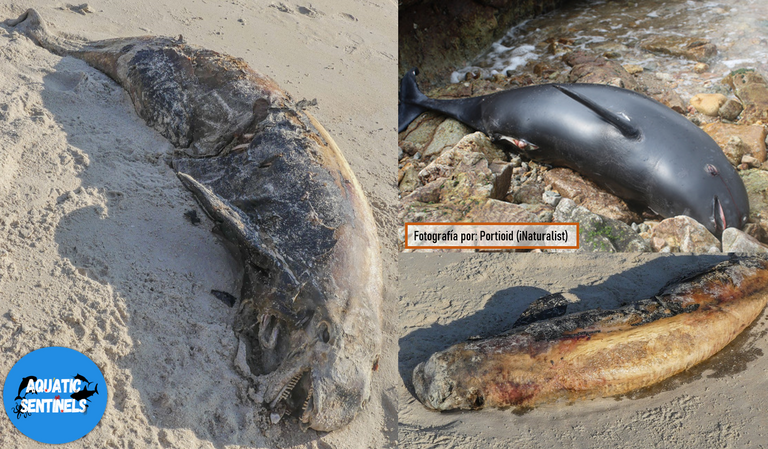
Photos by @eolianpariah📸
📍West Coast of India
Some time ago, a very interesting post came from @eolianpariah to our #AquaticSentinels community, who kindly shared his photographs captured in the West Coast of India, you can read his full post here👇 https://peakd.com/hive-154473/@eolianpariah/strange-creature-washed-up-on
We took on the task of making an identification through the photos, apparently it was Neophocaena phocaenoides (Indo-Pacific finless porpoise), although in reality we knew very little about them...
That is why the following post is dedicated to the Indo-Pacific finless porpoise, a species that needs special care to ensure its preservation, it has already shown itself to adapt very well to human care!
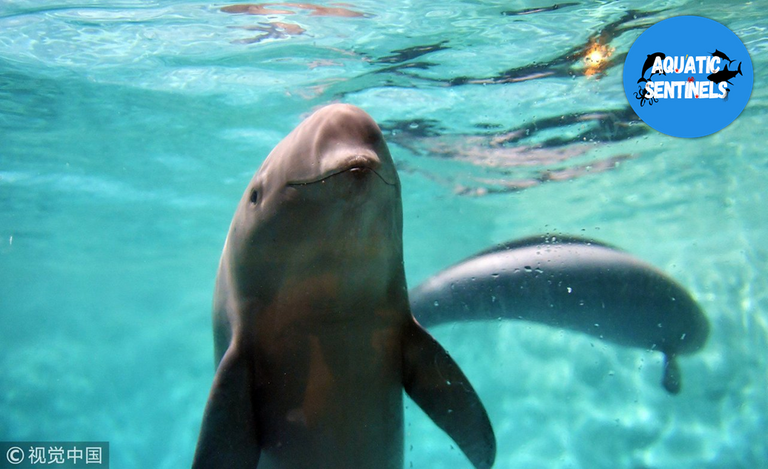
Photo by CGTN📸
📍Zhengzhou City, Henan Province, China
👉Join us until the end of this post to find out all the details👈...
The following information is taken from: Wang, J.Y. , Reeves, R. (2017). "Neophocaena phocaenoides". IUCN Red List of Threatened Species 2017.3. ISSN 2307-8235. Adapted by @juanbg

Porpoises, animals that look like "little dolphins"🐬
We find a large number of species when it comes to dolphins, different sizes and colors we will see in this family. On the other hand, porpoises are actually less known, so far only 6 species of porpoises are recognized, including the famous vaquita porpoise (Phocoena sinus)(we did another post about vaquita here) and also the Indo-Pacific finless porpoise (Neophocaena phocaenoides), unfortunately the two species find themselves in situations that are not good at all😞

Photo by CGTN📸
📍Zhengzhou City, Henan Province, China

"Sunameri"😄
"Sunameri" is the common name they receive in the waters of Japan, although it also lives in the coastal waters of Asia, especially in India, China, Indonesia and Japan. An impressive fact is that in addition to living in salt water, there is also a freshwater population in the Yangtze River in China!
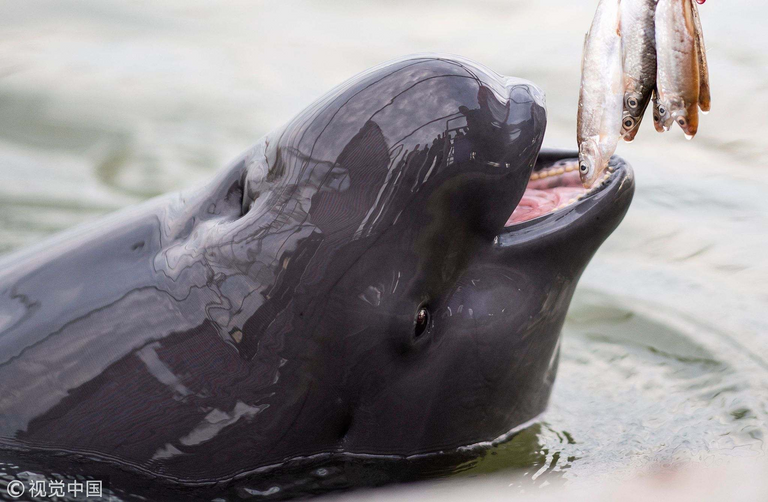
Photo by CGTN📸
📍Zhengzhou City, Henan Province, China
The name "finless porpoise" is due to the fact that they do not have a dorsal fin, so it would be somewhat difficult to confuse it with a dolphin. Young are darker gray in color, while adults are light gray. They are considered small marine mammals, measuring a little over a meter and a half in length and weighing between 30-45 kg. They feed on various species of fish and crustaceans.

Its population decreases every day📉
In 2006, a research estimated that there were only about 400 specimens left in the Yangtze River!
According to IUCN, and its last evacuation in 2017, it is a species that usually lives in shallow waters, the maximum depth reported is only 164 feets, this is one reason why many tend to die in fishing nets...
Most likely this is a reason why there are strandings of the species, and this is probably the reason for the sighting of @eolianpariah, interesting, right?🤔 And the following photos are similar too

Photo by Markus Baur📸
📍Vietnam
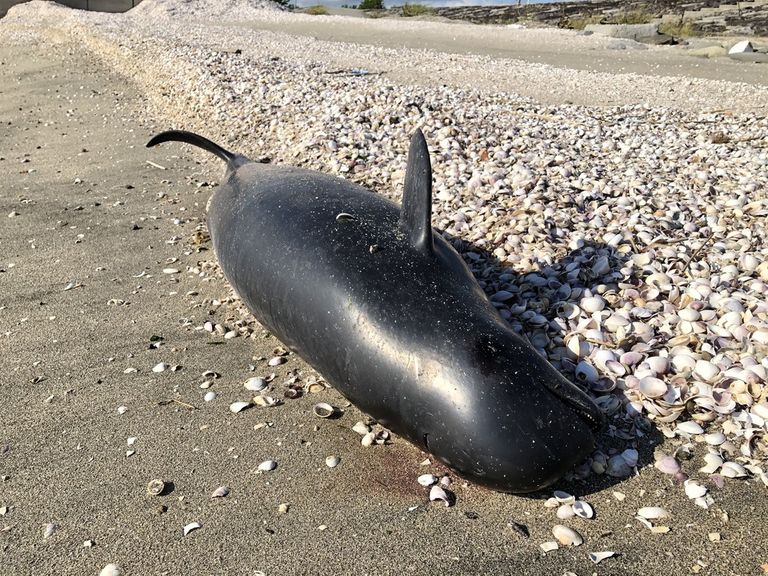
Photo by shangpan📸
📍Kumamoto, Japan

Conservation efforts
I have had the privilege of working with marine animals under human and professional care in order to generate more information about the species and in this way contribute to their conservation...
The main conservation strategy for the Indo-Pacific finless porpoise is precisely reproduction under human care, here is a video (courtesy of CGTN China) where we observe the relocation of porpoises to their natural habitat after they have passed for human care.
If we were to choose a guilty for the critical situation of our oceans of course we would have to look at ourselves, but we are also solely responsible for carrying out conservation plans for our species... and you, what are you doing for our oceans?

👉Join the Aquatic Sentinels!🐋
This project is dedicated to the preservation of our sea, our rivers and lakes, our lagoons. Let's make it possible! Let's share scientific and quality information for the good of our aquatic world!

🐟🐋Welcome!🐬🐙

DNA - Densifying Nature-Appreciation :
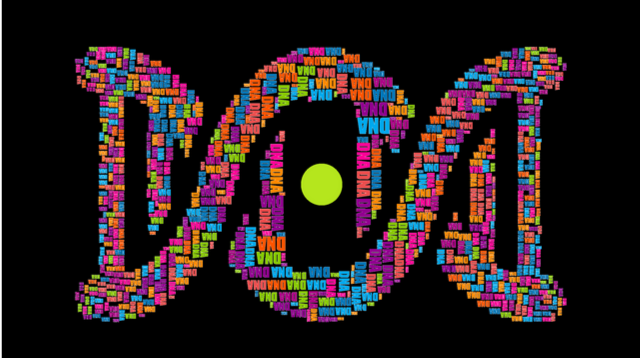
DNA is an organization to foster and DENSIFY NATURE-APPRECIATION which aims to establish REPORTS OF BIODIVERSITY DATA that is contributed by all of us Hiveans and subsequently cataloged.

DNA animation GIF by @Suheri
Therefore DNA searches for HIGH-QUALITY posts that aim to DESCRIBE and determine the BIODIVERSITY AROUND YOU with added EXPLANATIONS and INFORMATION. For these informative posts they offer a CURATION SERVICE using the @dna.org account. It is also a CURATION TRAIL. Just add the #dna TAG if you think that any of your posts is what they are looking for.

Aquatic Sentinels animation GIF by @juanbg

@juanbg: Leader of the Aquatic Sentinels Community
wonderful post. it is good to know there are conservation efforts already in place for the rivers but i guess most of the porpoises are in the sea
A few days ago I read a research that talks about conservation efforts in finless porpoise that come from the marine environment, it seems that they are also doing something for them!
great to hear
Hello @juanbg, this post is very good, although it saddens me, to see how humanity is capable of violating such beautiful animals and that like the rest of the creatures, they have their niche and their ecological function. This post is very didactic and illustrative of how detrimental human activity can be in ecosystems and with respect to a specific species.
In my country, Venezuela, many times when I traveled along the Orinoco River or visited the towns and cities that are on its banks, I could see the toninas, which are pink river dolphins. These animals have many stories, it is said that they have saved shipwrecked people from succumbing to the terrible current of the river, dragging them to safety or to the shore. I have always loved the beautiful spectacle of watching them leap over the surface of the water, or swim alongside the vessel, be it a large boat or a canoe. I believe that today, due to predation, pollution and the accelerated deterioration of the entire south of my country, they are no longer seen, it is a tragedy that this is happening.
Hola @sirenahippie así es, es muy triste saber que muchas veces somos la causa más grande de la extinción masiva de especies. Exactamente, el delfín rosado también es otra de esas especies que necesitan ayuda, sólo los planes de conservación más exitosos son los que salvarán especies. ¡Gracias por tu comentario!😄
Congratulations @juanbg! You have completed the following achievement on the Hive blockchain and have been rewarded with new badge(s) :
Your next target is to reach 4250 upvotes.
You can view your badges on your board and compare yourself to others in the Ranking
If you no longer want to receive notifications, reply to this comment with the word
STOPCheck out the last post from @hivebuzz:
Support the HiveBuzz project. Vote for our proposal!
Thanks for the supoort @hivebuzz!
You're welcome @juanbg 😊👍 That's with pleasure!
BTW, it would be much appreciated if you support our proposal so we can continue our work!
https://peakd.com/me/proposals/147
Thank you!